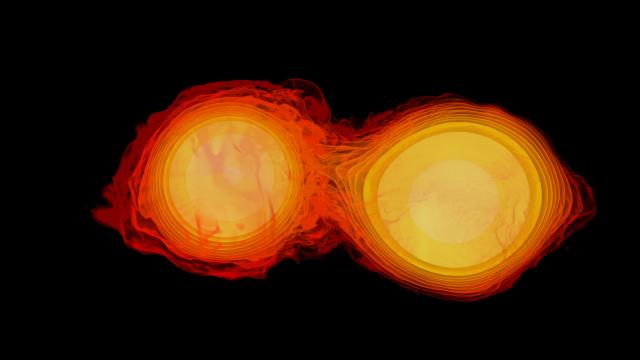When distant black holes (or neutron stars) collide, there’s a lot scientists can tell from the way they send gravitational waves rippling through space. That includes their masses, their distance, and how their spins line up with one another. But one question they’re still trying to figure out is, well, where are they?
Simulation of colliding neutron stars, an image I picked because it looked cool (Image: NASA Goddard Space Flight Center/Flickr)
There’s more to this story than mere appearances. Decoding the neighbourhood around these cataclysmic collisions could shed light on the origin stories of these black holes, and how they came to collide in the first place. Physicists think they have a new a way to help tell the full story of these colliding behemoths: By the way they spin into one another.
“We want to think about what’s nearby that can induce ellipticity,” Lisa Randall, Harvard theoretical physicist, told Gizmodo. “There’s this whole category of physics about how the environment can affect the merger.”
When a pair of black holes many times the mass of our sun come rip-roaring towards each other and collide, they send spacetime ripples throughout the universe in the form of gravitational waves. Scientists measure these waves with large experiments, like the two LIGO detectors that announced their gravitational wave discovery back in 2016. The signal looks like a wave quickly increasing in frequency before disappearing, like the sound of a water droplet falling from a tap.
These signals correspond to a pair of black holes (or neutron stars) spiraling inwards until they collide. But if a third supermassive black hole was nearby, one millions or even billions of times the mass of the Sun, perhaps it would alter the motion and therefore be detectable in the signal, according to Randall’s research published recently on the arXiv preprint server. The presence of some other mass could cause their collision course to take on a more elliptical shape.
Scientists are still trying to understand the mathematics behind measuring this ellipticity. But it’s not easy. “This [effect] is possibly the hardest to account for,” Imre Bartos, assistant professor at the University of Florida explained to Gizmodo, “for computational reasons.”
If scientists could take ellipticity into account, perhaps they could tell how these black holes formed, or even detect the presence of more exotic things, such as dark matter. One team cites the work in an attempt to rule out a kind of dark matter, too. “There’s a lot of different directions to go in and I can’t say which will lead to the most exciting results,” said Randall. “But now that we can actually see colliding black holes, it makes the question, ‘what can we learn from them,’ a lot more interesting.”
[arXiv]
